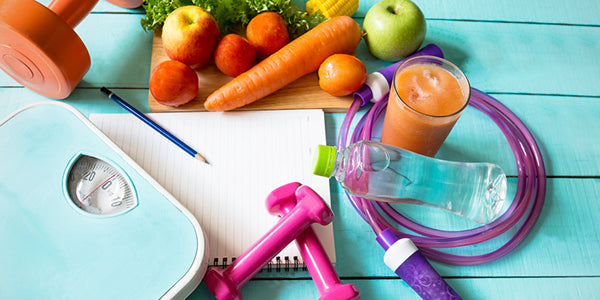
Find yourself expressing "I need to lose 20 pounds!" only to Google search "how to lose 20 pounds in 30 days?"
Do not fall victim to the diet claims promising dramatic weight loss in a short amount of time. Sustainable and lasting results requires much more than these gimmicky quick fixes.
Learn what it takes to lose 20 pounds and meet weight loss goals!
How to Lose 20 Pounds
Use this guide to lose weight in just 7 simple, yet practical steps!
Step 1: Consult with the Professionals
Before jumping into any sort of weight loss plan, consult with a primary care provider. They can help address any health concerns and assist in a custom plan to meet personal goals.
Furthermore, a Registered Dietitian can help guide you to appropriate healthy eating plan baring adequate nutrients while supporting weight loss. An athletic trainer can assist efforts in the gym safely and efficiently as well.
Step 2: Strategize a Safe, Sustainable Plan
One of the primary reasons most fad diets fail is because they not only promise fast results but extreme outcomes. This might be enticing at the moment, but true weight loss requires a safe, sustainable plan.
Healthy weight loss is a slow and safe manner bares lasting results. Most nutrition experts encourage losing no more than two pounds per week unless instructed and supervised by a healthcare professional.
Simply put, losing one pound of fat requires a 3,500 calorie deficit. So to lose one pound per week, this requires a caloric deficit of 500 calories per day. Losing two pounds weekly would equate to a 1,000 calorie deficit.
With these numbers in mind, losing 20 pounds can range from 3 to 6 months:
1 to 2 pounds per week X 4 weeks in a month = 4 to 8 pound loss
8 pounds X 3 months = 24 pounds
4 pounds X 6 months = 24 pounds
It is likewise important to note, though, people with more weight to lose are more likely to drop weight faster. For instance, someone trying to lose 50 pounds will likely lose 10 pounds faster than someone with 15 pounds to lose.
Ultimately, make a plan that fits personal goals and needs, as the best diet is the one you will stick to. And by doing works best for you and committing to your newfound lifestyle, long-term results are sure to follow!
Step 3: Evaluate the Diet
In an American diet, refined carbs, fast and fried foods, are abundantly consumed. Alas, this makes weight gain much easier and increases the risks of chronic diseases.
While half of the job is acknowledging such consequences, the other half is implementing components of a healthy diet. As a general rule of thumb, nutrient-dense foods include:
• Whole grains: Whole grains such as wheat, barley, and oats are packed with fiber and other nutrients that refined grains lack. Include eight, 1-ounce servings of whole grains on a daily basis.
• Fruits and veggies: Packed with fiber, vitamins, and minerals, fruits and veggies are key to providing nutrients the body requires. Loading up on them, especially non-starchy veggies, help control and cut calories naturally as well. Consume at least two servings of fruits and three servings of veggies each day.
• Lean proteins: Protein is important for weight loss, especially when choosing lean sources to control overall daily calories. Chicken, sirloin, fish, beans, tempeh, and low-fat dairy products are good sources of protein. As a general rule of thumb, consume 0.8 grams of protein per kilogram of body weight.
• Healthy fats: Whereas fat often has a bad reputation, the macronutrient is essential for overall health and weight loss. Swap out saturated and trans fats with unsaturated fat sources, including avocados, nuts and seeds, olive oil, and fatty fish.
Simple tips to nourish the body with adequate nutrients include:
• Fueling up for the day with a high-protein breakfast, including egg wraps and Greek yogurt parfaits.
• Meal prepping to reduce the temptation of drive-thru runs and help you stick to healthy meals.
• Shopping the store's perimeter, as the border houses lean meats, fresh produce, whole grains, and dairy products.
• Making healthy swaps in the kitchen to limit unwanted extra calories.
• Taking advantage of the Nutrition Facts and Ingredients labels. Opt for products without an extensive ingredient list and staying mindful of salt, sugar, and saturated and trans fat content.
• Halving the plate with non-starchy veggies and quartering it with protein and complex carb sources. Complement with a healthy fat. This plating method ensures adequate nutrients without the need to count calories diligently.
• Tuning into hunger and satiety cues and eating when hungry and stopping when feeling full.
Step 4: Increase Physical Activity
As they say, "Abs are made in the kitchen" and a solid workout regimen can accelerate weight loss results. Exercise is likewise helpful for maintaining a healthy weight.
But especially if new to exercise, work up to the recommended 150 minutes of cardio per week. Complete workouts you enjoy such as tennis, jogging, swimming, and Tabata training. Really, any activity that elevates heart rate is considered aerobic exercise.
Strength training helps build strength and muscle mass, in turn increasing metabolism even when the body is at rest. Make sure to weight train safely and incorporate at least two to three days of resistance training weekly. Focus on the major muscle groups, including the chest, arms, back, shoulders, and legs through bodyweight exercises or using machines.
Step 5: Make Small Changes
Weight and fat loss does require effort on your end. However, big results can likewise come from making small changes that develop into healthy habits. These may include:
• Waking up 30 minutes early to eat breakfast or embrace an early morning workout.
• Trying one new vegetable each week.
• Parking further away from entry doors.
• Taking the steps over the elevator.
• Carrying a water bottle to ensure adequate hydration.
• Prioritizing your day, including workouts, meal prepping, and at work.
• Powering down from electronics to calm stress and initiate better sleep.
Step 6: Confide in Support
Though weight loss follows from the efforts you put forth, forming support can ease difficult days. They likewise help overcome struggles whenever you need encouragement the most.
Form a strong support system filled with positive and motivated people to sustain a progressive trend. Support can come in the form of a significant other, family, friends, work friends, online communities, and others you fully trust.
And you never know, you might inspire others to embrace a healthier lifestyle and gain a workout buddy!
Step 7: Fall in Love the Process
Remember, weight loss and keeping it off is ongoing and essentially indefinite. Falling in love with the process makes the journey not only enjoyable but sustainable.
Also important, do not dwell on setbacks and what the scale reads. Truly, health is much more than the pounds lost as you gain so much more during your health journey!
So reflect on the dress you fit into again, strength gained, and amount of energy you feel. And not to mention, sporting a stronger mindset, boosted mood, and overall healthier, happier you!





